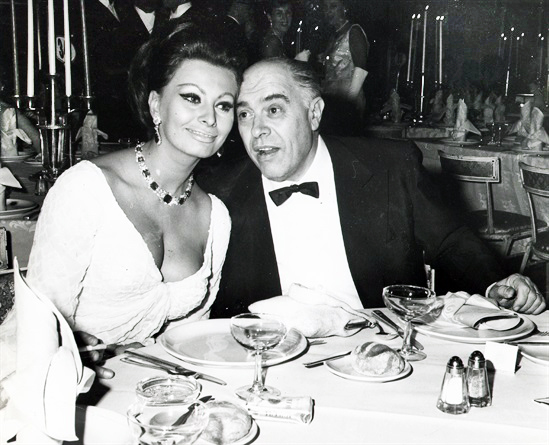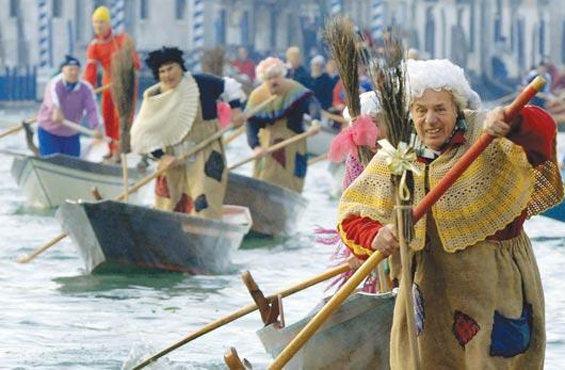Part 13 – De Laurentiis, Ponti and De Sica
This week we place the spotlight on three important men of the Italian Cinema, producers Dino De Laurentiis, Carlo Ponti and actor/director Vittorio De Sica.
Dino De Laurentiis was a film producer, who over his 60-year career, produced more than 600 films. He produced an extraordinary variety of films, including the Fellini-directed Oscar-winning Best Foreign Film, La Strada, co-produced with Carlo Ponti, and Nights of Cabiria.
He was born on August 8, 1919, in Torre Annunziata, outside of Naples. The son of a pasta maker, he went to Rome to study at the Centro Sperimentale di Cinematografia while in his teens and gained hands-on experience in film making. At the age of 20, De Laurentiis produced his first picture, Troppo tardi t’ho conosciuta (1939). This was soon followed by L’amore canta (1941). His work was soon affected by World War II. He scored his first international success with Bitter Rice in 1949, staring Silvana Mangano. Di Laurentiis and Mangano fell in love and married that same year and became a super couple in the Italian film world. The couple had four children and the marriage lasted nearly 40 years. They divorced in 1988 and Mangano died the following year. One of his grandchildren is Giada De Laurentiis, the host of numerous shows on the Food Network.
In the 1960s, De Laurentiis built his own studio facilities. During this period, though, heproduced such films as Barabbas (1961), The Bible: In the Beginning (1966), Kiss the Girls and Make Them Die, Navajo Joe (1966), Anzio (1968), Barbarella (1968) and Danger: Diabolik (1968).
De Laurentiis made several successful and acclaimed films during the 1970s, including Serpico (1973), Death Wish (1974), Three Days of the Condor (1975), The Shootist (1976), Ragtime (1981), Conan the Barbarian (1982), Blue Velvet (1986) and Breakdown (1997). His name became well known through the 1976 King Kong remake. He also produced the first Hannibal Lecter film, Manhunter in 1986 but passed on adapting the novel’s sequel, The Silence of the Lambs in 1991. He did produce the two follow-ups and the prequel. De Laurentiis died in 2010.
De Laurentiis’ films were often in collaboration with producer Carlo Ponti, who is the next producer spotlighted.
Carlo Ponti produced more than 150 films, including La Strada, War and Peace and Doctor Zhivago. He is also well remembered for having discovered and later marrying screen icon, Sophia Loren.
Ponti was born on December 11, 1912, in Magenta, Italy, a suburb of Milan. He graduated with a law degree from the University of Milan in 1934 and joined his father’s law firm. Although always interested in films, his entry in the world began through his law practice, by negotiating contracts in the industry.
Ponti accepted an offer from Riccardo Gualino’s Lux Film in Rome in 1941, where he produced a series of commercially successful films featuring the comedian Totò. Ponti produced the successful films Boccaccio ’70 (1962), Marriage Italian Style (1964) and Yesterday, Today and Tomorrow (1965), but his most popular and financially successful film was Doctor Zhivago, released in 1965. He subsequently produced three notable films with Michelangelo Antonioni, Blowup (1966), Zabriskie Point (1970) and The Passenger (1974).
In 1946, he married Giuliana Fiastri with whom he had a daughter and a son. While serving as a judge in a beauty contest in 1951, Ponti met a minor actress named Sofia Lazzaro (real name Sofia Villani Scicolone). Later that year, he cast her in his film Anna. In 1952, Ponti’s Goffredo Lombardo, head of production at Titanus, changed Lazzaro’s name to Sophia Loren.
Five years later, Ponti obtained a Mexican divorce from his first wife and married Sophia Loren by proxy. Divorce was still forbidden in Italy and ultimately, to avoid legal issues, Ponti, his first wife, Giuliana and Loren all moved to France and became citizens. Their applications for citizenship were personally approved by French President Georges Pompidou. Loren remained married to Ponti until his death in January, 2007.
The last to be spotlighted is a man whose directorial influence can be seen in the productions of countless films. Vittorio De Sica had a prolific career that spanned 55 years, in which he directed 35 films and acted in more than 150.
Born in Sora, Italy, in the Lazio region in 1902, De Sica began his career as an actor in 1918, with a small part in a silent film. Throughout the 1920s, he performed in films and musical theater and with touring companies before attaining stardom in Italy with his role in Mario Camerini’s 1932 film, Gli uomini, che mascalzoni! (What Rascals Men Are!). De Sica’s subsequent roles throughout the 1930s established him as a romantic leading man who was especially deft at light comedy, in the same manner as Cary Grant.
Although he maintained a successful acting career until the end of his life, De Sica’s directorial efforts, usually in collaboration with screenwriter Cesare Zavattini, are regarded as his most influential contribution to cinema history. The roots of Neorealism are found in De Sica’s early works, particularly Teresa Venerdì (1941) and I bambini ci guardano (1942). It was during the postwar era that De Sica became one of the world’s most acclaimed directors with four masterpieces: Sciuscià (1946’s Shoeshine), an account of the tragic lives of two children during the American occupation of Italy; Ladri di biciclette (The Bicycle Thief, 1948), an Oscar winner for Best Foreign Film; Miracolo a Milano (Miracle in Milan, 1951), a dark comedy about the clash of rich and poor in Milan and Umberto D. (1952), a tragedy about a lonely retiree, his dog and a young maid who takes pity upon them both.
In addition, to his directing success, De Sica continued to be a successful actor. He was nominated for an Academy Award for his performance in A Farewell to Arms (1957). In 1970, De Sica’s Il giardino dei Finzi-Contini won the Oscar for Best Foreign Film. De Sica’s last film, Il viaggio (1974’s The Voyage), paired Richard Burton with De Sica’s favorite actress, Sophia Loren. He died in Paris later that year.





